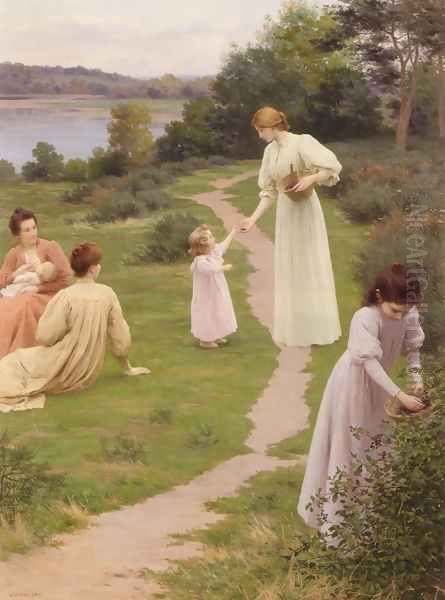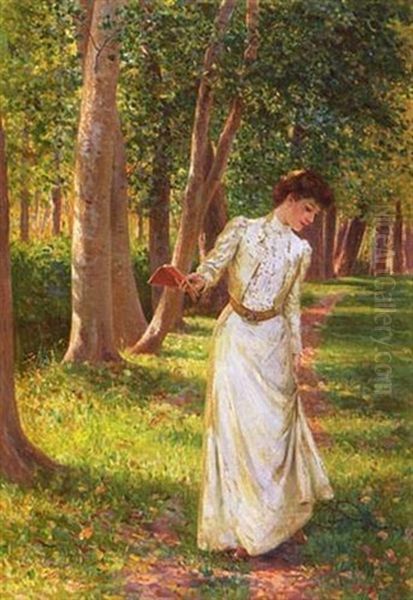Leopold Franz Kowalski (1856-1931) was an artist whose career unfolded against the vibrant and rapidly changing backdrop of late 19th and early 20th-century Paris. While perhaps not a revolutionary figure who drastically altered the course of art history, Kowalski carved out a distinct niche for himself, creating works appreciated for their charm, technical skill, and gentle depiction of life, particularly focusing on rural landscapes, elegant figures, and scenes imbued with a quiet narrative. His artistic journey reflects a period of transition, where traditional academic approaches coexisted and sometimes intermingled with newer, more experimental movements like Impressionism.
Early Life and Artistic Formation in Paris
Born in 1856, sources vary regarding Leopold Franz Kowalski's precise place of birth, with some indicating Hungary and others suggesting France. Regardless of his birthplace, his artistic identity became firmly rooted in France, particularly in Paris, which was then the undisputed capital of the art world. Like many aspiring artists of his generation, Kowalski sought formal training to hone his skills. He enrolled at the prestigious École des Beaux-Arts in Paris, a bastion of academic tradition.
At the École, students underwent rigorous training, emphasizing drawing from classical sculptures and live models, the study of anatomy, perspective, and art history. This classical grounding provided a solid foundation in draughtsmanship and composition. During his studies, Kowalski is noted to have been a student of respected academic painters such as Jean Pillard and Henri Lehmann. Lehmann, himself a student of the great Neoclassicist Jean-Auguste-Dominique Ingres, would have instilled in his pupils a respect for line, form, and carefully constructed compositions. This academic training would remain evident in Kowalski's work, even as he absorbed contemporary influences.

The Paris of Kowalski's formative years was a crucible of artistic innovation. While the École des Beaux-Arts upheld tradition, the Impressionist movement had already challenged academic conventions with its emphasis on capturing fleeting moments, the effects of light and atmosphere, and scenes of modern life, painted en plein air. Artists like Claude Monet, Pierre-Auguste Renoir, and Edgar Degas were revolutionizing painting, and their influence, whether accepted or resisted, was pervasive. Kowalski, while not an Impressionist in the strictest sense, would undoubtedly have been aware of these developments, and elements of their approach to light and color can be discerned in his later works.
Artistic Style and Thematic Focus
Leopold Franz Kowalski developed a style that skillfully blended academic precision with a softer, more atmospheric sensibility, often leaning towards genre painting and idyllic representations of femininity and nature. He became particularly known for his depictions of elegant women, often dressed in the fashionable attire of the period, situated in lush gardens, tranquil countryside settings, or engaging in leisurely pursuits. These scenes evoke a sense of peace, refinement, and a gentle nostalgia, characteristic of the Belle Époque.
His subject matter frequently revolved around pastoral landscapes, intimate garden scenes, and figures interacting within these environments. He demonstrated a keen ability to capture the textures of fabrics, the delicate rendering of flowers, and the interplay of light and shadow. While his figures were often idealized, they possessed a lifelike quality and a sense of quiet contemplation. Kowalski's palette was generally rich and harmonious, capable of conveying both the vibrancy of a sunlit garden and the more subdued tones of an interior or a shaded grove.
There is an indication that Kowalski's style evolved throughout his career, moving from a more strictly Realist approach, grounded in his academic training, towards a lighter, more Impressionistic handling of paint and light in some of his works. This might be seen in a looser brushwork or a greater emphasis on capturing the ephemeral qualities of a scene. However, he generally retained a strong sense of form and structure, distinguishing his work from the more radical dissolution of form seen in some Impressionist painters. The claim that his work ventured into abstraction seems less substantiated by his known oeuvre, which largely remained figurative. His strength lay in creating appealing, well-executed paintings that resonated with the tastes of his time.
Prominent Works and Exhibitions

One of Leopold Franz Kowalski's most frequently cited works is "La promenade" (The Walk). This painting, a canvas measuring 65.5 cm x 46.5 cm, exemplifies his characteristic themes and style. While the current location of this specific piece is often listed as unknown, its imagery typically aligns with his depictions of elegantly dressed women in natural settings, perhaps strolling through a park or garden. Such works captured a popular sentiment of the era, celebrating leisure and the beauty of the cultivated landscape.
Other titles attributed to Kowalski further illustrate his thematic concerns, including "Picking Flowers," "Berry Picking," and a piece sometimes referred to as "Framed Study by Leopold Franz Kowalski." These titles suggest a continued focus on figures, often female, engaged in gentle activities within natural environments. "Picking Flowers" and "Berry Picking" directly point to idyllic, rural pastimes, allowing the artist to combine figure painting with landscape and still life elements (the flowers or berries themselves). The "Framed Study" indicates his dedication to preparatory work and the importance of observation in his artistic process. Another work, sometimes cryptically titled "la main chaude who touched," hints at genre scenes that might involve games or social interactions, common subjects in 19th-century painting.
Kowalski was an active participant in the Parisian art scene, regularly exhibiting his works. He began showing at the prestigious Paris Salon from 1881. The Salon, organized by the Académie des Beaux-Arts, was the official, juried exhibition and the primary venue for artists to gain recognition, attract patrons, and establish their careers. To be accepted into the Salon was a significant achievement. His consistent presence there suggests that his work found favor with the juries and the public, aligning with the prevailing aesthetic standards while also offering a personal touch. The Salon showcased a wide array of styles, from the grand historical and mythological paintings of academic masters like William-Adolphe Bouguereau or Jean-Léon Gérôme, to portraits, landscapes, and genre scenes by numerous other artists.
The Parisian Art World: Contemporaries and Context
Leopold Franz Kowalski operated within a rich and diverse artistic milieu. Paris in the late 19th and early 20th centuries was a magnet for artists from across Europe and America. His teachers, Jean Pillard and Henri Lehmann, represented the established academic tradition, which continued to hold considerable sway despite the challenges from avant-garde movements.

The Impressionists, such as Claude Monet, Pierre-Auguste Renoir, Edgar Degas, and Camille Pissarro, had already made their mark by the time Kowalski was establishing his career. Their focus on light, color, and contemporary life offered a stark contrast to academic history painting. While Kowalski was not a core member of this group, the general shift towards brighter palettes and more informal subject matter, partly popularized by the Impressionists, likely influenced his work to some degree.
Beyond the Impressionists, many other artists explored different facets of Realism and Naturalism. Painters like Jules Breton and Léon-Augustin Lhermitte were renowned for their dignified portrayals of peasant life and rural labor, sharing Kowalski's interest in countryside themes, albeit often with a more pronounced social realist undertone. The works of artists like James Tissot or the Italian expatriate Giovanni Boldini, known for their glamorous portraits of society women, offer a different perspective on the depiction of contemporary femininity, often more urban and overtly fashionable than Kowalski's typically pastoral subjects.
It is also important to distinguish Leopold Franz Kowalski from other artists with the same surname, particularly Alfred Wierusz-Kowalski (1849-1915). Alfred Wierusz-Kowalski was a prominent Polish painter associated with the Munich School, celebrated for his dramatic scenes of Polish history, hunting expeditions, and winter landscapes, often featuring horses and wolves. While a contemporary, his style, thematic concerns, and national focus were quite distinct from those of Leopold Franz Kowalski, the Parisian painter.
The art world also included figures who were pushing beyond Impressionism. Post-Impressionists like Paul Cézanne, Vincent van Gogh, and Paul Gauguin were already laying the groundwork for modernism, though their radical innovations might have seemed far removed from Kowalski's more accessible style. Nevertheless, the air in Paris was thick with artistic debate and experimentation, creating a dynamic environment for all practicing artists. Kowalski's adherence to a more traditional, yet charmingly rendered, form of figurative art provided an appealing alternative for patrons who appreciated skilled craftsmanship and pleasing subjects.
Later Life, Legacy, and Art Historical Position
Information regarding Leopold Franz Kowalski's later life suggests that, like many of his generation, his experiences were shaped by the tumultuous events of the early 20th century. It is noted that he served as a volunteer during World War I, and this period reportedly had a detrimental impact on his health. Such service would have interrupted his artistic production and undoubtedly left a profound personal mark.
Kowalski passed away in 1931. In the broader sweep of art history, he is recognized as a skilled and sensitive painter who contributed to the tradition of French genre and landscape painting. He may not be counted among the groundbreaking innovators who radically reshaped artistic paradigms, like Monet or Cézanne, but his work holds a legitimate place as representative of a particular sensibility prevalent in the late 19th and early 20th centuries. His paintings offered an escape into idealized worlds of pastoral beauty and refined leisure, appealing to a public that valued technical accomplishment and charming subject matter.
His art reflects a careful observation of nature and human figures, a mastery of traditional techniques learned at the École des Beaux-Arts, and an ability to imbue his scenes with a gentle, often romantic, atmosphere. The evolution in his style, incorporating lighter palettes and a more fluid application of paint, shows an awareness of contemporary artistic currents like Impressionism, even if he did not fully embrace its revolutionary aspects. He successfully navigated the Parisian art world, exhibiting regularly at the Salon and finding an audience for his work.
Today, Leopold Franz Kowalski's paintings are appreciated for their aesthetic appeal, their depiction of a bygone era, and their competent artistry. They provide insight into the tastes and cultural values of the Belle Époque and the period leading up to the First World War. While perhaps overshadowed by more famous names, his contributions enrich our understanding of the diversity of artistic production in Paris during a pivotal era of artistic change. His works continue to appear in art markets and collections, attesting to their enduring charm and the skill of their creator.
Conclusion
Leopold Franz Kowalski stands as a noteworthy artist of his time, a French painter, possibly of Hungarian origin, who skillfully captured the pastoral charm and refined sensibilities of the late 19th and early 20th centuries. Educated in the classical tradition of the École des Beaux-Arts under masters like Henri Lehmann, he developed a distinctive style characterized by elegant figures, lush landscapes, and a gentle, narrative quality. His regular exhibitions at the Paris Salon from 1881 onwards testify to his acceptance and recognition within the competitive Parisian art world.
Works such as "La promenade," "Picking Flowers," and "Berry Picking" exemplify his thematic preferences, often focusing on women in idyllic natural settings. While not an avant-garde revolutionary, Kowalski's art shows an intelligent assimilation of contemporary influences, subtly incorporating elements reminiscent of Impressionism in his treatment of light and atmosphere, while retaining a strong foundation in academic draughtsmanship. He was a contemporary of giants like Monet and Renoir, as well as respected Salon painters like Bouguereau and genre specialists like Jules Breton, navigating his own path within this vibrant artistic landscape. His legacy is that of a talented and dedicated artist whose paintings continue to evoke the grace and tranquility of a past era, appreciated for their technical finesse and enduring aesthetic appeal.